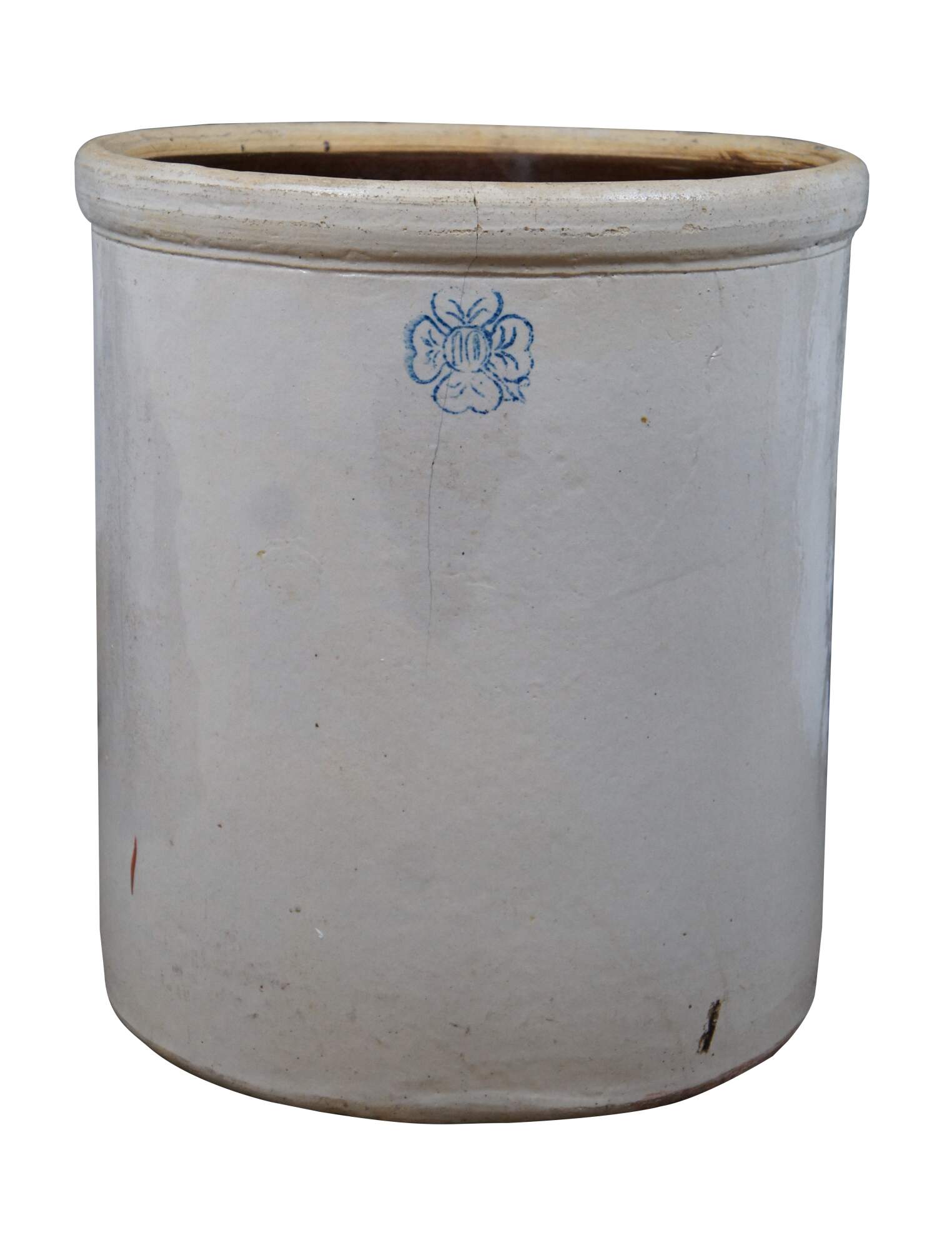
Shipping:
Free Shipping Included
Delivery:
Estimated 2-15 Business Days
Payments:
Credit Card, Check, Cash, PayPal, Apple Pay, Venmo
Returns:
30 Days 100% Money Back Guarantee, Buyer Pays Return Shipping
Description
Antique late 19th – early 20th century 10 gallon stoneware crock with off white salt glazed exterior and brown glazed interior, crafted by Miller’s Pottery of Alabama, stamped with their blue four leaf clover mark.
“Miller's Pottery, located in Brent, Bibb County, is one of the few remaining traditional potteries in the United States. The pots themselves are made from the Alabama clay of Perry County, and the Miller family's 150-year history of pottery making incorporates traditions brought from Europe and cultivated in the American South. In recent years, the Millers have added a national clientele of folk art collectors to their long-standing market of local residents and regional hardware stores.
Pottery making had a long tradition in the region. Indeed southeastern Native American tribes had been making pottery for centuries prior to the arrival of Europeans. They traditionally made their earthenware pots by coiling or molding clay, and they generally did not use glazes. The earliest European settlers in the region generally produced pots with a smooth, glossy lead-glazed finish. In the Mobile Bay area during the eighteenth century, however, new European immigrants brought more advanced pottery technology, including the use of the wheel and new glaze techniques, that quickly supplanted the earlier traditions. By the 1840s, potters on the eastern shore of Mobile Bay had begun producing high-fired stoneware with a matte-finish salt glaze, which gave the pots an appearance and texture similar to the skin of an orange. This type of glaze was probably introduced into the area by French immigrant potters, including Francis LaCoste, who first appeared near the present-day community of Montrose in the 1850 U.S. Census for Baldwin County.
In approximately 1870, Abraham Miller, a former Union soldier from Lancaster, Pennsylvania, came to work for the LaCoste family, married LaCoste's daughter Frances, and learned the pottery trade. Miller soon moved his new family north to Perry County, in central Alabama, to work in the potteries near Sprott. He later founded his own pottery, where Miller and his sons produced glazed stoneware jugs, churns, and other utilitarian items needed by his rural customers. In the early twentieth century, Abraham's son William took charge of the business, aided by his sons, Hendon and Norman. They became part of a vibrant pottery-making community that also included potteries run by the Ham, Hughey, and Smith families. In the early 1930s, Hendon and Norman took charge of the family pottery and worked in partnership until about 1957, when they closed up shop to start individual businesses. In 1964, Hendon Miller moved to the town of Brent in southern Bibb County and opened a shop on Highway 5. He chose the site for its nearby natural gas line and fitted his shop with a gas-fired kiln, thus eliminating the need to fire with wood. Hendon Miller specialized in terracotta planters and other garden ornaments but also continued to produce a few glazed pieces. Older cousins Kenneth Miller and Sherman Hughey helped out at the pottery, as well.
Norman opened the Norman Miller Pottery in Sprott, where he produced table wares, utilitarian forms such as churns, and flower pots. He closed his shop in the late 1970s. Hendon Miller died in 1983, and his son Eric took charge of the Highway 5 shop, which he continues to run today. He and his son Steve still collect clay from the same Perry County site that his forefathers visited. The Millers, and their partner, cousin Allen Ham, have re-introduced glazed stoneware to the shop's repertoire. The family's notoriety and the timeless utility of the pots continue to attract customers and collectors.”
(Joey Brackner, Alabama Center for Traditional Culture - Encyclopedia of Alabama)
Condition
Good antique condition - Couple of hairline cracks; some stains/wear commensurate with use.
Dimensions
15.25” x 17.5” (Diameter x Height)